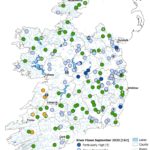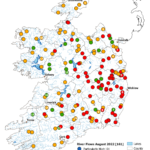The Hydrology Bulletin for September is now on the EPA…
Hydrology Summary Bulletin – September 2022
The September 2022 Hydrology Summary Bulletin outlines the flows in rivers, rainfall, lake and turlough levels, groundwater levels and spring outflows of over 300 stations across Ireland for the month. Despite increases in rainfall since August, average lake levels and river flows in the North and West remained below normal for September.
Overview
Rainfall was above average in most places and was highest in the midlands, south and east. Average river flows for September increased at 89% of flow monitoring stations compared to average flows observed for August. Almost half (45%) of river monitoring stations observed monthly average flows in the ‘normal’ range with a further 40% having lower than normal flows for September. Average lake levels remained low, with 75% of lakes lower than normal for this time of year. Groundwater levels increased at almost two-thirds (64%) of monitoring stations, although 81% of monitoring wells were lower than the normal range for September. Similarly, most monitored spring outflows, especially those in the northwest, were ‘particularly low’ for this time of year.
Rainfall
The majority of monthly rainfall totals were above their 1981 – 2010 Long-Term Average (LTA). Percentage of monthly rainfall values ranged from 74% (the month’s lowest monthly rainfall total of 75.9 mm) at Finner, Co Donegal to 220% (monthly rainfall total of 153.2 mm) at Oak Park, Co Carlow (its wettest September on record (length 17 years)). Monthly rainfall totals were as much as 175.8 mm (percentage of LTA 140%) at Valentia Observatory, Co Kerry. The highest daily rainfall total was 43.5 mm at Cork Airport, Co Cork on Wednesday 7th. The number of rain days ranged from 14 days at several stations to 22 days at Knock Airport, Co Mayo. The number of wet days ranged from 11 days at Johnstown Castle, Co Wexford to 17 days at Markree, Co Sligo. The number of very wet days ranged from 2 days at a few stations to 9 days at Valentia Observatory, Co Kerry. Dublin Airport, Co Dublin had its wettest September since 1976 with 128.0 mm, Phoenix Park, Co Dublin had its wettest September since 1999 with 128.8 mm and Moore Park, Co Cork had its wettest September since 2006 with 139.9 mm.
River Flows
Average river flows for September increased at 89% monitoring stations compared to average flows observed in August. River flows were predominantly in the ‘normal’ range and correspond to the south and eastern half of the country. River flows in the ‘below normal’ range were observed in the north and western half of the country. Analysis of monthly average flows at 161 river monitoring sites across the country identified; 4 (2%) as ‘particularly high’, 20 (12%) as ‘above normal’, 73 (45%) as ‘normal’, 50 (31%) as ‘below normal’ and 14 (9%) as ‘particularly low’ for this time of year.
Lake and Turlough Levels
Average water levels for September increased at 50% of monitored lakes compared to average levels for August. Analysis of monthly average levels at 44 lakes and 4 turloughs were classified as ‘particularly high’ at 2 (4%), ‘above normal’ at 1 (2%) [L. Eske, Co. Donegal], ‘normal’ at 9 (19%), ‘below normal’ at 22 (46%) and ‘particularly low’ at 14 (29%) of monitoring locations for the month of September.
Groundwater Levels and Spring Flows
Average groundwater levels in September increased at 64% of monitoring wells compared to average levels observed in August. September groundwater levels were classified as ‘particularly high’ at 1 well [NU1 Deep, Co. Kilkenny – Chart 6], ‘normal’ at 7 wells (17%), ‘below normal’ at 24 wells (59%) and ‘particularly low’ at 9 wells (22%) across the country. Figure 3: Percentage distribution of groundwater level sites within each of the percentile flow categories for September 2022. Spring outflows were also monitored at 6 EPA monitoring sites for September. The outflows from these springs were compared to previously recorded flows for September, and were ‘normal’ at 2 locations, ‘below normal’ at 1 location and ‘particularly low’ at 3 monitoring locations for this time of year.







